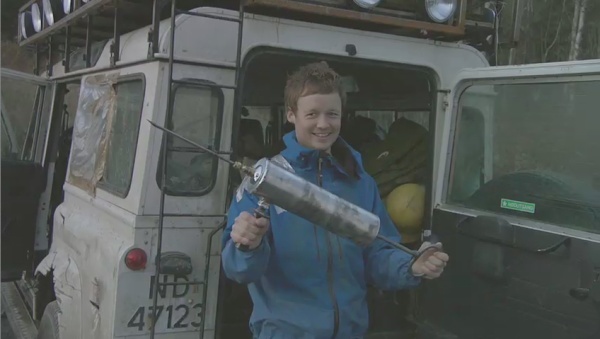2010 // Norway // André Øvredal // November 19, 2011 // Netflix Instant
In most respects, the Norwegian horror-fantasy Troll Hunter is a fairly representative “found footage” thriller. It possesses the jittery camerawork, generally unpleasant characters, and old-school matinee-monster teases that are now bedrock elements of that sub-genre. What most distinguishes director André Øvredal’s film is the engaging mythological framework that it constructs for its story, a framework that the film regards with affection and sincerity while also acknowledging its innate absurdity. Absent an intense and detailed viral marketing campaign—as in The Blair Witch Project or Cloverfield—most found footage features do a dreadful job of conveying the broader fantastical universe that rustles outside the audience’s field of view. Too often, every aspect of these films is pitched slavishly to the camera’s eye, with little regard for textured world-building, as though a first-person camera automatically bestows all the necessary verisimilitude. Not so with Troll Hunter, which utilizes expository dialog, creative set design, and four or five thrilling special effects set-pieces to intimate a rich and dryly amusing pagan-fantasy mythos. (In this respect, Troll Hunter plays as a wily, lo-fi cousin to the Nordic-influenced How to Train Your Dragon.)
The conceit: All the footage that the film presents was ostensibly shot by a group of student documentarians—director/interviewer Thomas (Glenn Erland Tosterud), sound woman Johanna (Johanna Mørck), and cameraman Kalle (Tomas Alf Larsen)—who are shadowing a suspected bear poacher in western Norway. Despite being curtly warned off by their subject, Hans (Otto Jespersen), the trio doggedly follows his movements through campgrounds and rugged wilderness areas, going so far as to tail him during a nocturnal expedition into the forest. Eventually, the students stumble upon the outlandish truth: Hans is no poacher, but a government-employed field agent (the only field agent, actually) for the Troll Security Service (TSS). Disillusioned by decades of thankless work under an agency that values secrecy above all else, Hans agrees to allow the students to film his lonely, day-to-day routine, as well as his matter-of-fact explanations of troll biology and behavior. This proves to be the set-up for the real meat of Troll Hunter, which is a succession of fearsome, often funny encounters with different varieties of troll.
The unsuccessful aspects of Troll Hunter are distressingly familiar within the annals of found footage cinema. The only truly compelling character in the film is Hans, a reserved and hard-nosed old salt who doesn’t have a shred of romanticism left about his life’s work, but betrays a streak of wary fondness for trolls. Every other character is either featureless or actively unlikable, which necessarily restrains the tension of the various action-horror sequences. The film drags a bit in spots, and is liberally padded with lingering shots of the admittedly gorgeous winter landscapes of rural Norway, to the point where it seems to have ambitions as a promotional film for Scandinavian tourism. However, fifteen or so minutes of bloat notwithstanding, the story is neatly structured around Hans’ investigation of a recent, unprecedented rise in troll rampages, with each scene revealing new details and flowing smoothly into the next. The whole thing is a bit schematic and predictable at times--when a 500-foot-tall troll species is mentioned in passing, its eventual appearance is virtually guaranteed--but still gratifyingly executed.
Troll Hunter never quite figures out whether it wants to treat its titular monsters as wholly scientific subjects or émigrés from a lost magical era. The film offers some biological gobbledygook to explain why trolls turn to stone when exposed sunlight, but elsewhere ridicules other alleged attributes as fairy-tale nonsense. On the one hand, Hans states flatly and without elaboration that trolls are definitely mammals. On the other, the film doesn’t even attempt to present a pseudo-scientific explanation for trolls’ ability to smell Christian blood, a characteristic that proves to be a crucial plot point. Such contradictions might have been more vexing if Troll Hunter weren’t having so much vintage monster-movie fun with its signature creatures. The sheer spectacle of seeing mythological brutes marauding through a contemporary landscape is half the appeal of the film, which does a marvelous job of conveying the threatening nature of the trolls while also portraying them as faintly ludicrous. Blessedly, the viewer is spared the sight of “darker, edgier” trolls. Instead, the creature designs draw from the works of whimsical contemporary fantasy artists, such as Brian Froud’s witty creations and Rien Poortvliet’s seminal illustrations for Wil Huygen’s gnome books.
Troll Hunter takes sardonic aim at a wide variety of targets: romanticism and revisionism regarding Europe’s pagan past; the glib flimsiness of hero myths; government bureaucracy and its aversion to transparency; and the tension between development and environmentalism. It’s not what one could call a vicious work of satire—it is Norwegian, after all—but in the end, the modesty of the film’s cultural commentary proves a wise decision. Troll Hunter functions first and foremost as an old-fashioned creature feature, one that boasts an absurdly deep mythology and abundant moments of giddy, comic terror.




